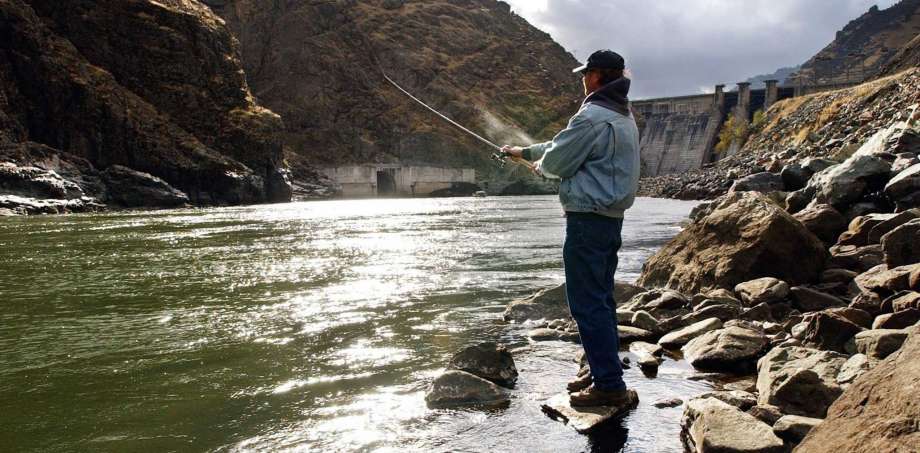forum
library
tutorial
contact

Recovery Plans for Snake River
Salmon, Steelhead Released
by Keith Ridler
Seattle Post-Intelligencer, December 12, 2017
|
the film forum library tutorial contact |

|
Recovery Plans for Snake River
by Keith Ridler
|
 BOISE, Idaho -- Authorities have released recovery plans for federally protected Snake River chinook salmon and steelhead intended to make sure each species is self-sustaining in the wild.
BOISE, Idaho -- Authorities have released recovery plans for federally protected Snake River chinook salmon and steelhead intended to make sure each species is self-sustaining in the wild.
The final plans released Tuesday by National Oceanic and Atmospheric Administration Fisheries include spring and summer chinook, fall chinook and steelhead. Authorities listed the three runs as threatened in the 1990s.
On a larger scale, the documents will be used by NOAA Fisheries to develop a biological opinion in late 2018 that will direct how federal agencies operate 14 federal dams in the Columbia River Basin to protect salmon and steelhead.
The documents will also be used in creating an environmental impact statement, or EIS, by other federal agencies and ordered by a federal judge in 2016 concerning the 14 dams. The court ruled that the U.S. government hasn't done enough to improve Northwest salmon runs and ordered the environmental review that's due out in 2021, urging officials to consider removing four big dams on the Snake River.
NOAA Fisheries in the documents released Tuesday evaluates dam breaching but doesn't take an official position. In general, the documents say removing the dams could improve runs but by how much varies based on complex factors.
The salmon and steelhead that are the focus of the documents are part of a commercial and sport fishery, and are also important to tribes in the region that hold treaty rights.
In general, federal officials said during a conference call Tuesday, fall chinook are doing better than spring and summer chinook and steelhead.
"We are really on track to recover (fall chinook)," said Ken Troyer, Northern Snake River Branch chief for NOAA. "The challenges are greatest for spring and summer chinook and steelhead."
The 366-page fall chinook plan identifies three main strategies, and chooses to implement the third one that's intended to boost the number of naturally reproducing spawning fish in the Snake River below Idaho Power's Hells Canyon Complex of hydroelectric dams.
The plan says that young fish released in specific areas will return to those same areas to spawn as adults. That, officials say, will help boost the numbers of naturally reproducing fish and eventually lead to a self-sustaining population needed to achieve recovery.
That plan "is the most likely and timely path to recovery," said Rosemary Furfey, Snake River Recovery Coordinator for NOAA.
The Hells Canyon Complex cut off upstream spawning habitat and in the document is listed as a reason for the decline of the fish. Problems confronting fisheries managers in returning salmon above the dams is that the area is heavily used for agriculture and is too environmentally degraded to support salmon.
"At this time, we recognize that the habitat is not conducive to fish populations and having fish survive," said Ritchie Graves, Columbia Basin Hydropower Branch chief for NOAA.
Also, Idaho lawmakers previously approved a law preventing the return of listed species to Idaho without the state's approval. Idaho Gov. C.L. "Butch" Otter has said he doesn't want listed fish above the dams, which could force expensive habitat restoration.
The 284-page recovery plan for spring and summer chinook and steelhead mainly looks at protecting existing tributary habitat and restoring degraded habitat. Those species travel into the Clearwater River and its tributaries in northern Idaho and the Salmon River and its tributaries in central Idaho. Fish also go into the Grande Ronde River in Oregon.
Troyer said that Idaho has habitat that's in great shape, but "we see a lot of potential for habitat improvement and fish survival. We don't know exactly what that is. But I do feel there is a lot left to be done in Idaho."
The plans released Tuesday are the final two recovery plans from NOAA Fisheries for the Columbia River Basin's 13 endangered and threatened salmon and steelhead runs.
David Wilson, spokesman for Bonneville Power Administration, said the agency will include the most recent plans in the environmental impact statement and will continue to coordinate with NOAA to recover listed species.
Related Pages:
New Plans for Some Threatened Salmon Will 'Not Get Us to Recovery,' Feds Say by Rocky Barker, Idaho Statesman, 12/12/17
Snake River Sockeye Recovery to Take 50-100 Years Under Final Plan by Rocky Barker, Idaho Statesman, 6/8/15
redfishbluefish comments 6/9/15:
How will the Sockeye Recovery Plan achieve recovery of Idaho's Sockeye? Please tell us.bluefish.org is offering a $5000 reward to anyone that can show how the federal plan will bring about the recovery of Idaho's wild Sockeye Salmon. See www.bluefish.org website home page for details.
learn more on topics covered in the film
see the video
read the script
learn the songs
discussion forum
